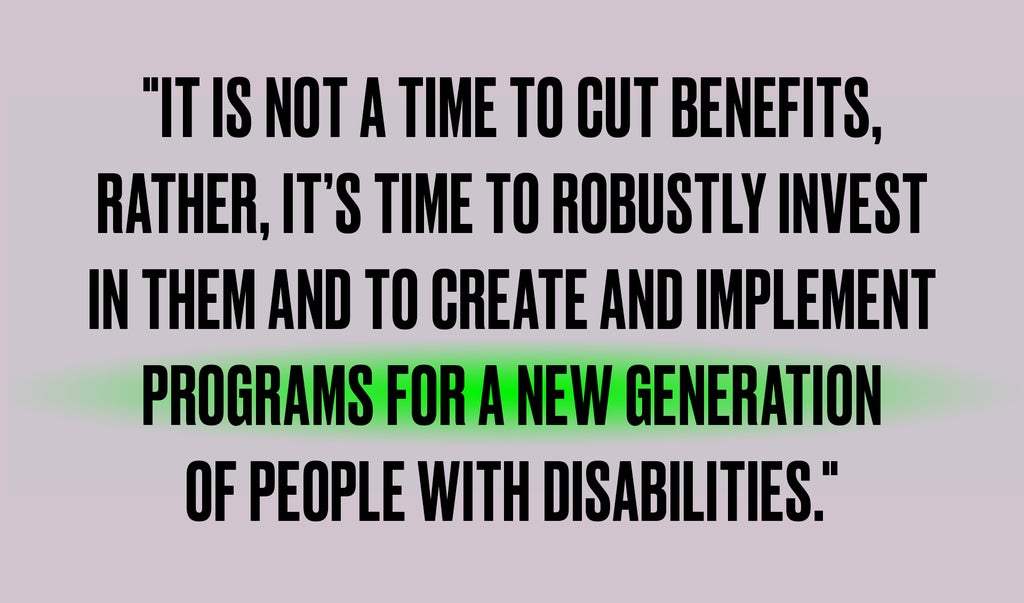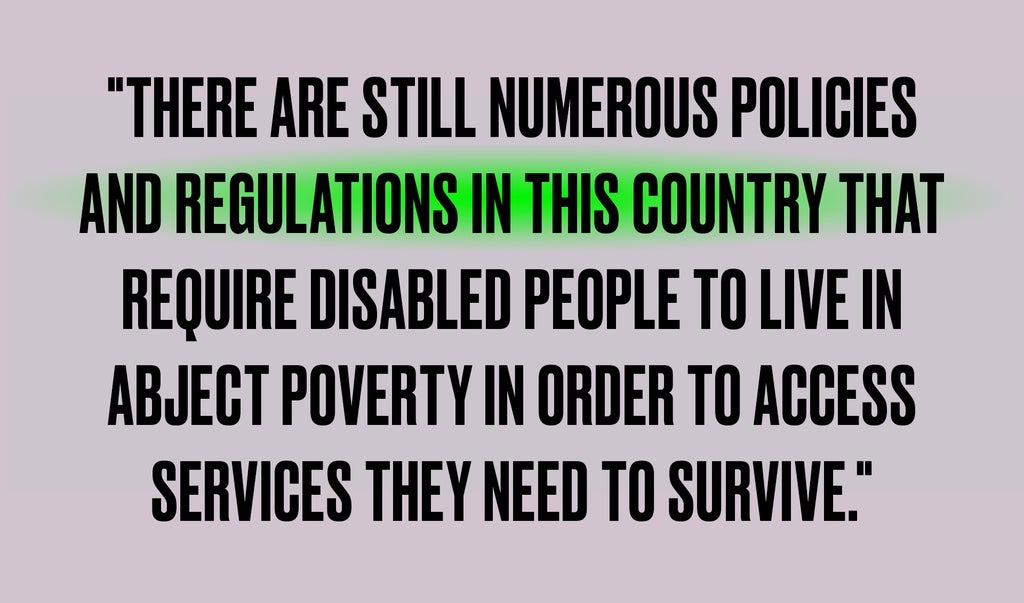Eighty-three years ago, then-president Franklin D. Roosevelt signed the Fair Labor Standards Act. By many accounts, the FLSA was groundbreaking. It established the minimum wage, overtime rules, child labor standards, and formal workplace record keeping — which are all great things. Yet it also created a legal loophole that resulted in the authorization of section 14(c), permitting employers to pay a certain class of disabled workers a subminimum wage.
The symbolism of the most well-known disabled president signing into law a policy that would legislate poverty for disabled people should not be lost on us. But thankfully, laws and policies that created and enforced civil rights protections for people with disabilities have evolved from this period.
The Rehabilitation Act of 1973 (part of the Workforce Investment Act), and the significant amendments that were added, prohibited discrimination against people with disabilities by any entity receiving federal dollars, including jobs and schools. Soon after, the Individuals with Disabilities Education Act of 1975 increased the inclusion of students with disabilities in classroom settings alongside their non-disabled peers.
Thanks in large part to the advocacy of people with disabilities who were bolstered by these strides, the Americans with Disabilities Act (ADA) was passed in 1990. As the most comprehensive civil rights bill since the Civil Rights Act of 1964, it prohibited discrimination against people with disabilities in employment, transportation, public accommodations, and technology across the country.
These are vital protections, but like the loophole in the FLSA, they exist alongside other policies and regulations that require disabled people to live in abject poverty in order to access services they need to survive. Despite the longstanding myth that people who receive earned entitlements are living high on the hog, and the notion that disabled people are “fakers, takers, and moneymakers,” the truth is often the exact opposite.
The reality is that additional, non-reimbursable costs of living with a disability can decimate any hope of a balanced home budget. A person with a disability may be tasked with paying for a specialized diet, personal assistance costs, and the maintenance of existing accommodations and supports (such as software upgrades and structural repairs). Those costs add up quickly. In 2020, the National Disability Institute released a report on the extra costs of living with a disability, which demonstrated that for the average adult with a disability to achieve a similar standard of living as their non-disabled counterpart, they would need to have 28% more income. But people who receive disability benefits get an average of $1,279 a month. In 2020, the average full-time salary worker earned $984 a week, more than three times that amount.

It’s not easy to qualify for and obtain disability benefits, in part because the system is not designed in a customer-centered way. Over 10,000 people die a year while waiting for a judge to decide whether to grant them disability benefits. Between 2008 and 2009, over 110,000 Americans died while waiting for an appeal, after initially having a claim denied. And 48,000 people filed for bankruptcy while waiting for a resolution in their case between 2014 and 2019, according to a report from the U.S. Government Accountability Office.
What this dire problem calls for is a better-funded system with more staff to respond to filings and paperwork. Yet, during the Trump administration, there were multiple attempts to sabotage it. Social Security (SSA) offices were closed during the pandemic. An efficient and positively regarded telework program was shut down. SSA attempted to fundamentally increase the number of benefit reviews, a move that would make it even harder for people with disabilities to secure crucial benefits. SSA also implemented a proposed rule to no longer use a “lack of English proficiency” as a contributing factor in the application process, likely resulting in fewer disabled and impoverished people of color accessing benefits they sorely need.
One of the most powerful things about the concept of “disability” is the elasticity of the term. The definition of disability in the ADA centers on “any mental or physical impairment that impacts activities of daily life.” That definition includes children who acquire conditions as a result of drinking lead-contaminated water, women with postpartum depression, people with eating disorders — and those with long-haul symptoms of the coronavirus. Estimated to impact at least five million people globally, COVID-19 is going to clearly demonstrate that the current social safety net does not stretch far enough. It is not a time to cut benefits; rather, it’s time to robustly invest in them and to create and implement programs for a new generation of people with disabilities.
With this in mind, there are proposals on the horizon that strive to counteract the legislation that has kept, and continues to keep, people with disabilities in poverty. For instance, it’s still legal to pay some workers a subminimum wage, or an amount under the enforced minimum wage, under the aforementioned section 14(c) passed by FDR. As recently as March 2021, the Raise the Wage section of the American Rescue Plan Act of 2021 was removed, which would have raised the minimum wage and eliminated the subminimum wage for workers with disabilities. But there is hope that a proposed solution, the Transformation to Competitive Employment Act, will see another day. Introduced most recently in the 116th Congress, it would include a six-year graduated phase-out of the subminimum wage, with targeted incentives to help providers make the transition to competitive, integrated employment endorsed in the campaign.

Another antiquated and damaging law that must change is asset limits. People with disabilities on Supplemental Security Income (SSI), are unable to have more than $2,000 in a bank account, or $3,000 if they’re married. While these limits are supposedly there to sustain services to those in most need, they actually make it impossible for individuals to save money for fear of losing their benefits. What’s more, the maximum limit has not been increased in over 30 years; back then, a gallon of gas was a dollar and two people could go on a date to a movie — with snacks — for under $10. The proposed ASSET Act would eliminate asset limits for Supplemental Nutrition Assistance Programs, Low Income Home Energy Assistance Programs, and Temporary Assistance for Needy Families Program. It would raise ASSET limits for individuals on Supplemental Security Income up to $10,000 for an individual, and $20,000 for couples.
Finally, recent changes to state Medicaid policies have resulted in legislation requiring individuals on Medicaid to work in order to receive benefits. While the federal government required states to exempt those who fit the definition of “medically frail” where implemented, many people with disabilities who have less consistent employment outcomes or are unable to work full-time — including people living with mental illnesses and chronic health conditions, and cancer survivors — could be affected. People can file for an exemption, but they may be asked to provide extensive documentation of their medical condition, which can be costly, time-consuming, and labor-intensive. A month after inauguration, however, the Biden Administration has moved to rescind current work requirements and is recalling permissions given to states for implementation of these programs.
The solutions being proposed to work against these punitive policies are only a start. While they would function as remediation for past wrongs and a way to help lift people with disabilities out of poverty going forward, truly undoing decades of legally-enforced poverty will take radical social change. But, just as the Great Depression led to Roosevelt’s New Deal, there is hope that the pandemic and its accompanying period of economic upheaval will also precede an equally robust investment in the social safety net — but this time, one that will not leave people with disabilities behind.
Like what you see? How about some more R29 goodness, right here?
Britney Spears Conservatorship & Disability Rights
A Week In Texas On Disability (Follow Up)
I'm A Black, Disabled Actor & I'm Ready To Work
from Refinery29 https://ift.tt/36zVxNo
via IFTTT
